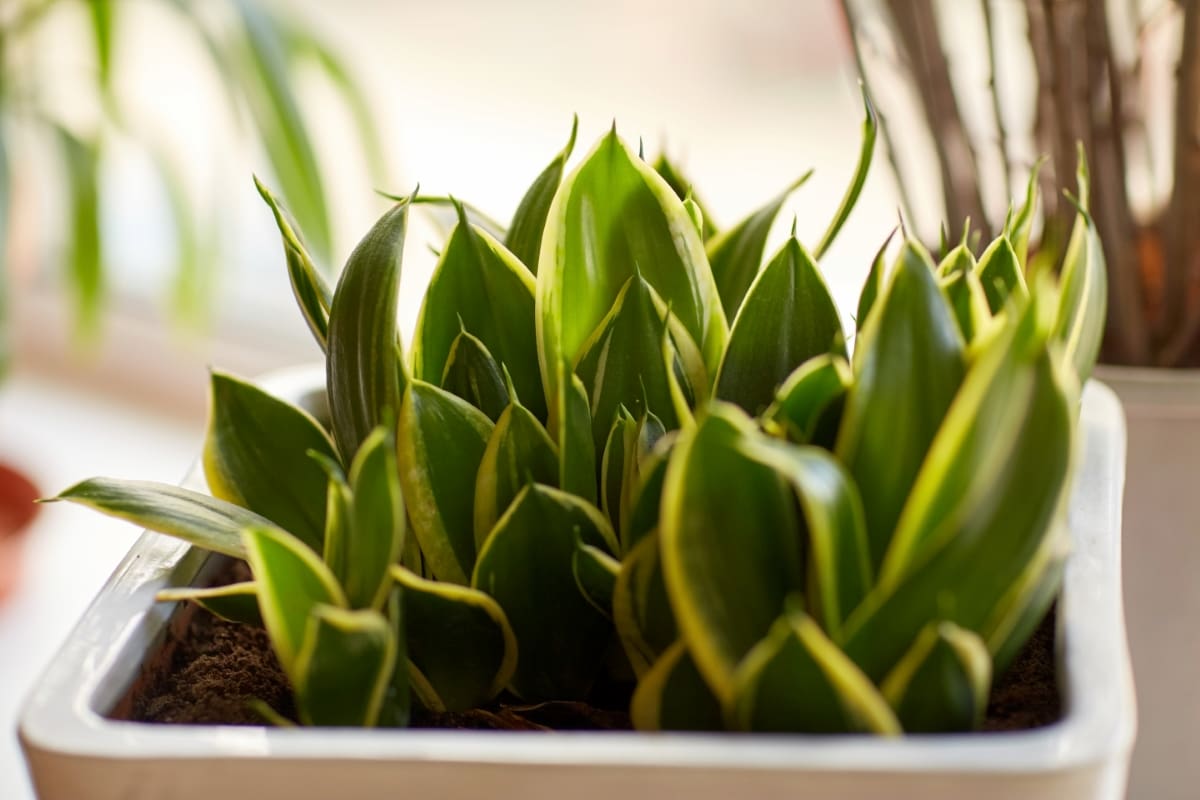The snake plant (Sansevieria), known for its hardy nature and air-purifying qualities, requires proper fertilization for optimal growth. Understanding snake plant fertilization is crucial for cultivating vibrant and healthy specimens. These resilient plants thrive in well-draining soil and benefit from a balanced, diluted liquid fertilizer during the growing season (spring and summer).

A general-purpose, half-strength fertilizer provides essential nutrients every 4-6 weeks without risking over-fertilization. However, reducing or ceasing fertilization in fall and winter is vital when the plant’s growth slows. Striking a balance between nutrient supply and plant needs ensures the longevity and lushness of this low-maintenance and visually appealing indoor greenery.
Best Fertilizers to Make Snake Plant Bushy
Know the Important Nutrients for a Healthy Snake Plant
Snake plants benefit from a balanced fertilizer, typically with an NPK 10-10-10 or 20-20-20. Nitrogen (N) promotes leaf development, phosphorus (P) supports root growth and flowering, while potassium (K) aids overall plant health. Additionally, micronutrients such as iron, magnesium, and manganese play vital roles in chlorophyll production and enzyme activation.
Choosing a well-balanced, water-soluble fertilizer and applying it at half-strength during the growing season is crucial. Monitoring the soil’s pH and adjusting it to the slightly acidic to neutral range (6.0-7.0) ensures optimal nutrient absorption, contributing to the snake plant’s resilience and vitality.
Use Organic Fertilizers for Snake Plants
Opting for organic fertilizers enhances the well-being of snake plants while promoting environmental sustainability. Organic choices, like compost or well-rotted manure, foster soil health and microbial activity, aiding nutrient absorption. These natural amendments provide a slow-release nutrient source, reducing the risk of over-fertilization. Worm castings and fish emulsion offer balanced nutrition, fostering robust growth without synthetic chemicals.
Organic fertilizers improve soil structure, water retention, and overall microbial diversity, creating a more resilient and self-sustaining environment for snake plants. Furthermore, organic options align with eco-conscious gardening practices, minimizing the environmental impact of traditional synthetic fertilizers. By choosing organic, gardeners can cultivate healthier snake plants while contributing to a greener and more sustainable approach to plant care.
Consider the Best Liquid Fertilizers for Snake Plants
Selecting the right liquid fertilizer is crucial for optimal snake plant health. Balanced formulations with equal NPK ratios, such as 10-10-10 or 20-20-20, are ideal. Water-soluble, liquid fertilizers like seaweed extracts or fish emulsions offer a quick nutrient boost, aiding leaf and root development. Additionally, specialized snake plant fertilizers are available to meet their unique needs. These liquid fertilizers are convenient for controlled application and ensure a consistent nutrient supply.
Dilution is key to prevent over-fertilization; applying at half strength for every 4-6 weeks during the active growth season supports vigorous growth. Carefully chosen liquid fertilizers contribute to the resilience and vibrancy of snake plants, making them a valuable addition to a plant care routine.
Opt for Slow-Release Fertilizers for Bushy Snake Plants
For optimal growth of bushy snake plants, consider using slow-release fertilizer spikes. These spikes provide a consistent and gradual nutrient release over an extended period, promoting sustained plant health. Unlike quick-release fertilizers that may cause fluctuations in nutrient levels, slow-release options deliver a steady supply, reducing the risk of over-fertilization.
In case you missed it: List of Rare Snake Plant Varieties: A Guide to Unique Sansevieria Species

This is particularly beneficial for snake plants, as they generally prefer moderate nutrient levels. The convenience of these spikes also simplifies the fertilization process, requiring less frequent applications. Choose a formula specifically designed for houseplants, and follow package instructions for the best results in cultivating lush and vibrant bushy snake plants.
Fertilize Your Indoor Snake Plants
Fertilizing indoor snake plants is crucial for sustained health. Opt for a balanced, water-soluble fertilizer with an NPK ratio of 10-10-10 or 20-20-20. During the growing season (spring and summer), dilute the fertilizer to half-strength to prevent overfeeding. Apply every 4-6 weeks, providing essential nutrients for robust growth. Consider using specialized snake plant fertilizers or organic alternatives like compost tea for a natural approach.
Always check soil pH, maintaining a slightly acidic to neutral range (6.0-7.0), to ensure optimal nutrient absorption. Refrain from fertilizing during fall and winter when the plant’s growth slows. Consistent and mindful fertilization contributes to vibrant, thriving indoor snake plants, enhancing their aesthetic appeal and air-purifying qualities.
Use the Right Fertilizer Ratios for Bushy Snake Plants
Achieving a bushy and lush appearance in snake plants requires careful consideration of fertilizer ratios. Opt for a balanced formulation with equal NPK ratios, such as 10-10-10 or 20-20-20, to support overall growth. These ratios provide essential nutrients for foliage development, root strength, and overall plant vitality. During the growing season (spring and summer), apply a water-soluble fertilizer at half strength every 4-6 weeks.
In case you missed it: Snake Plant Drooping: Possible Causes, Remedies, and Treatment

This measured approach ensures a steady nutrient supply without the risk of over-fertilization. Additionally, incorporating organic options or specialized snake plant fertilizers can enhance the plant’s resilience. Striking the right balance in fertilizer ratios is key to cultivating a thriving, bushy appearance in snake plants, adding beauty to indoor spaces.
Adjust Fertilization in Different Seasons for Snake Plants
Choose a balanced, water-soluble fertilizer with an NPK ratio of 10-10-10 or 20-20-20, applying it at half strength every 4-6 weeks. This regimen supports robust growth, lush foliage, and overall plant health. As fall approaches, gradually reduce fertilization frequency, allowing the plant to enter a period of dormancy. In winter, when growth slows, it’s advisable to cease fertilization entirely. Overfeeding during dormant periods may lead to nutrient imbalances and stress the plant.
Observing the plant’s behavior is crucial; signs of slowed growth or reduced vigor indicate the need for less frequent fertilization. Additionally, soil testing for nutrient levels and pH adjustments can fine-tune the fertilization strategy. By tailoring the fertilization routine to the distinct demands of each season, gardeners ensure their snake plants’ long-term health and resilience, fostering a harmonious balance between growth and dormancy throughout the year.
Try Diy Fertilizer Recipes for Bushy Snake Plants
Enhance the business of your snake plants with DIY fertilizer recipes. Mix equal parts of well-decomposed compost and vermicompost for a nutrient-rich base. Add a tablespoon of Epsom salt to promote magnesium uptake, which is crucial for leaf development.
For an organic boost, create a banana peel fertilizer by soaking banana peels in water for a few days and using the infused water. Apply these homemade fertilizers sparingly during the growing season, ensuring a balanced nutrient supply. Tailoring your fertilizers allows for a personalized touch, contributing to the lushness and vibrancy of your bushy snake plants in an eco-friendly manner.
Apply Fertilizers Using Proper Techniques for Snake Plants
Apply fertilizers to snake plants using proper techniques for optimal results. Water the soil thoroughly before fertilizing to prevent root burn—dilute liquid fertilizers to half-strength to avoid overfeeding. Apply the fertilizer evenly around the base, avoiding direct contact with the leaves. The soil should be moist but not soggy during application.
In case you missed it: Best Time to Repotting Snake Plant: Problems and Solutions After Repotting

Aim for consistency, fertilizing every 4-6 weeks during the growing season. Monitor the plant’s response, adjusting the frequency if needed. Incorporate organic options or specialized snake plant fertilizers for a balanced approach. By employing these techniques, you promote healthy growth and vibrant foliage while preventing potential issues associated with improper fertilization.
Conclusion
In conclusion, achieving a bushy snake plant involves choosing the right fertilizers. Careful consideration of these options, coupled with proper application techniques, fosters lush growth, contributing to snake plants’ overall health and aesthetic appeal. The key lies in a balanced and tailored approach to meet the plant’s unique nutritional needs.
- Feed Your Flock for Less: Top 10 Tips to Save on Chicken Feed
- Ultimate Guide to Ossabaw Island Hog: Breeding, Raising, Diet, and Care
- Hatching Answers: The Top 10 Reasons Your Chickens Aren’t Laying Eggs
- Eggs and Economics: Breaking Down the Cost of Raising Backyard Chickens
- Defend Your Greens: Proven Methods to Keep Iguanas Out of Your Garden
- Ultimate Guide to Cinnamon Queen Chicken: A Comprehensive Guide for Beginners
- Ultimate Guide to California Tan Chicken: Breeding, Raising, Diet, Egg-Production and Care
- Ultimate Guide to Marsh Daisy Chicken: Breeding, Raising, Diet, and Care
- 10 Types of Chicken Farming Businesses You Can Start for Profits